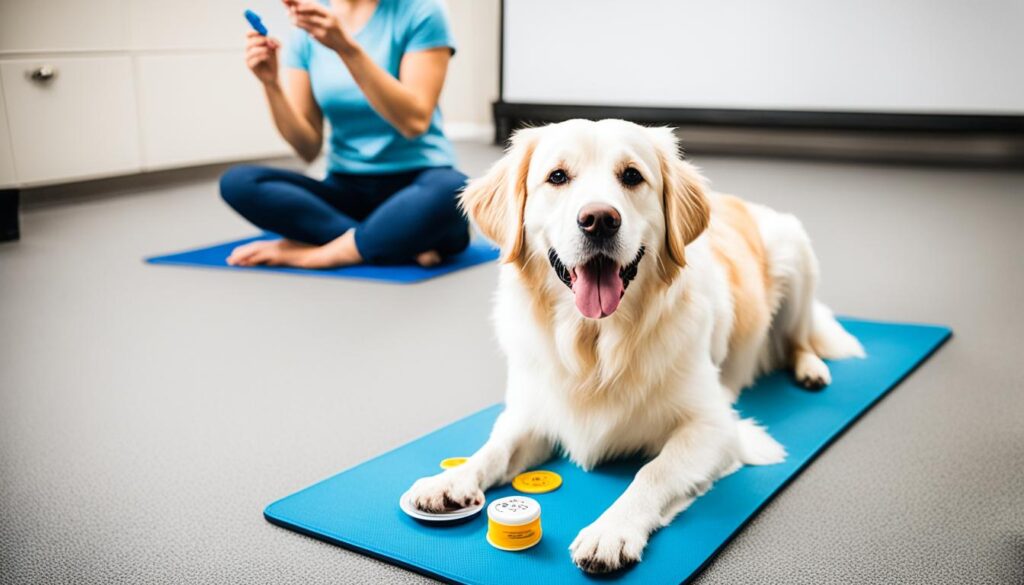Welcome to our comprehensive guide on training your pet for success. Whether you have a dog or a cat, training them is much more than just teaching basic commands. It is a journey of mutual growth and learning that strengthens the bond between you and your furry friend.
Pet training is essential for shaping their behavior, preventing behavioral issues, and ensuring their safety. It also provides mental stimulation, enhances communication and understanding, and opens doors to continued educational opportunities. With the right techniques and consistent training, you can foster a successful and fulfilling relationship with your pet.
In this article, we will explore the importance of pet training, the positive outcomes it brings, and how it contributes to the overall wellbeing of your pet. We will share expert insights, success stories, and valuable tips to inspire and guide you on your pet training journey.
Key Takeaways:
- Training your pet is a journey of mutual growth and learning.
- Pet training prevents behavioral issues and ensures their safety.
- Training provides mental stimulation and enhances communication.
- Consistent training opens doors to continued educational opportunities.
- Expert insights and success stories inspire and guide your pet training journey.
The Importance of Behavioral Immunization in Pet Training
Behavioral immunization, also known as early training, is a critical aspect of pet training that helps prevent behavioral issues such as aggression, fear, and anxiety in pets. By providing training at an early stage, you lay a solid foundation for your pet’s future behavior and ensure they become well-socialized.
How Early Training Prevents Behavioral Issues
Early training plays a vital role in preventing behavioral problems in pets. By introducing them to positive reinforcement techniques and teaching basic commands from a young age, you can shape their behavior and set them up for success. Properly trained pets are more confident, obedient, and less likely to exhibit unwanted behaviors in adulthood.
The Positive Outcomes of a Well-Socialized Pet
Socialization is a key component of pet training, and it significantly influences the overall outcomes. When pets are properly socialized, they learn to interact confidently with humans and other animals. This allows them to navigate various situations and environments with ease, leading to better behavior and adaptability. Well-socialized pets are more likely to be relaxed, friendly, and well-behaved, making them a joy to be around.
By emphasizing behavioral immunization through early training and prioritizing socialization, you can ensure that your pet grows into a well-rounded and well-socialized companion, capable of thriving in different social and environmental contexts.
Embracing Dog Training Education Month
Fostering Harmony Through Training
Training Contributes to Canine Wellbeing
Dog Training Education Month, celebrated in February, highlights the importance of training in fostering a harmonious relationship between humans and dogs. Training contributes to the overall wellbeing of canines by providing effective communication and understanding between dogs and their owners. It helps shape their behavior, teach them acceptable social conduct, and enhances their safety in different situations. Canine wellbeing is improved through mental stimulation and building a trusting bond with consistent training.
Training your dog is a valuable investment in their happiness and overall wellbeing. By participating in Dog Training Education Month, you have the opportunity to deepen the connection with your four-legged companion and create a harmonious living environment. Through training, you can establish clear expectations, improve communication, and shape desirable behaviors in your dog. This leads to a happier, healthier, and more well-adjusted pet.

Training your dog not only provides them with the necessary skills and obedience but also strengthens the bond between you and your canine companion. It fosters trust, enhances communication, and reinforces the sense of security in your dog. By investing time and effort in training, you are creating a positive and enriching environment that promotes your dog’s mental and emotional wellbeing.
Additionally, training contributes to the overall harmony and balance in your dog’s life. By teaching them acceptable social conduct and providing mental stimulation, you are setting them up for success in various situations and environments. A well-trained dog is more adaptable, confident, and better equipped to handle new experiences and challenges.
Furthermore, training plays a crucial role in ensuring the safety of your dog. Through proper training, you can teach them vital commands such as “sit,” “stay,” and “come,” which can help prevent dangerous situations and keep them out of harm’s way. Training also enables you to address any behavioral issues or concerns early on, ensuring a safe and secure environment for both your dog and those around them.
| Benefits of Dog Training | |
|---|---|
| 1. Improved communication | 5. Enhanced mental stimulation |
| 2. Strengthened bond and trust | 6. Better socialization and adaptability |
| 3. Shaping desirable behaviors | 7. Ensured safety in different situations |
| 4. Preventing behavioral issues | 8. Overall canine wellbeing |
By participating in Dog Training Education Month, you are joining a community dedicated to the positive and holistic development of dogs. You have the opportunity to gain valuable insights, learn effective training techniques, and connect with fellow dog enthusiasts and professionals.
Remember, training is an ongoing process that requires patience, consistency, and dedication. It is a lifelong commitment to your dog’s growth and wellbeing. Embrace Dog Training Education Month as a chance to deepen your bond with your furry friend and create a happy and harmonious life together.
Understanding Your Pet’s Language for Deeper Connection
Building a deeper connection with your pet involves understanding their unique language. Pets communicate through body language, vocalizations, and other behaviors. By learning to interpret and respond appropriately to their cues, you can establish a stronger bond and enhance your communication. Understanding your pet’s language also helps in identifying their needs, emotions, and potential behavioral issues.
“Pets have their way of expressing themselves, and it’s our role as pet owners to tune in and listen. Their nonverbal cues and behaviors speak volumes about their feelings and needs.” – Dr. Sarah Johnson, Animal Behavior Specialist
Take the time to observe and familiarize yourself with your pet’s body language. Pay attention to their facial expressions, tail movements, ear position, and overall posture. These subtle cues can provide valuable insights into their emotional state and help you provide appropriate care and support.
Vocalizations also play a significant role in pet communication. Different barks, meows, purrs, and growls can convey varying messages. For example, a high-pitched bark may indicate excitement or alertness, while a low growl may signal aggression or fear. By understanding these vocal cues, you can respond accordingly and address any potential issues.
In addition to body language and vocalizations, pets also communicate through their behaviors. For example, a dog may wag its tail to express happiness or approach someone with a relaxed posture to show friendliness. Cats may knead their paws to demonstrate contentment or vocalize for attention. By recognizing and responding to these behaviors, you can deepen your connection with your pet and ensure their well-being.
Remember, every pet is unique, and their communication styles may vary. Spend quality time with your pet, be patient, and observe their preferences and reactions. This will help you establish a deeper connection and strengthen the bond you share.
Shaping Desirable Pet Behavior with Proper Techniques
Proper training techniques are essential for shaping desirable behavior in pets. By utilizing effective methods, you can establish a foundation for your pet’s behavior training, ensuring they develop positive habits. One crucial aspect of training is teaching basic commands and social conduct. These fundamental skills lay the groundwork for your pet’s overall behavior and interaction with others.
Consistency is key when practicing training techniques. By employing positive reinforcement and reward-based training, you can encourage and motivate your pet to exhibit desired behaviors. This approach emphasizes the importance of rewarding good behavior, reinforcing positive habits, and minimizing undesirable traits.
Training your pet to respond to basic commands such as “sit,” “stay,” and “come” is essential for their safety and convenience. It enables you to keep them under control in different situations and environments. Social conduct training, on the other hand, focuses on teaching your pet proper behavior around other animals and people. This training helps them become well-mannered and confident in various social settings. Such skills not only benefit your pet’s behavior but also foster harmonious interactions with others.
Employing proper techniques in shaping desirable pet behavior ensures a well-behaved companion and strengthens the bond between you and your furry friend.

Note: The image above showcases the importance of shaping desirable pet behavior.
Maintaining Safety with Obedience Training
Obedience training plays a significant role in ensuring the safety of your pet. By teaching vital safety commands through effective training techniques, you can create a safer environment for both you and your furry companion.
Teaching Vital Safety Commands to Your Pet
One of the key aspects of obedience training is teaching your pet essential safety commands. These commands, such as recall and stay, are crucial for their response and compliance in risky situations. By reinforcing these commands consistently, you can instill discipline, control, and focus in your pet, preventing them from engaging in potentially hazardous behavior.
Preventing Accidents Through Effective Training
Accidents can happen, but with effective training, you can significantly minimize the risk. Obedience training helps prevent accidents by teaching your pet to follow instructions and stay out of harm’s way. By instilling good behavior and impulse control, you can reduce the likelihood of your pet getting into dangerous situations and ensure their safety.
Whether it’s teaching them to avoid certain areas, stay by your side during walks, or respond to safety commands promptly, obedience training gives you the tools to create a safer environment for your pet.
Comparative Analysis of Safety Commands
| Command | Definition | Importance |
|---|---|---|
| Recall | A command that calls your pet back to you. | Crucial for preventing your pet from running into dangerous situations or approaching potentially harmful objects or animals. |
| Stay | A command that requires your pet to remain in a specific position until given further instructions. | Helps keep your pet in a safe place, preventing them from wandering into traffic, approaching strangers, or entering areas with potential hazards. |
| Leave it | A command that instructs your pet to move away from or avoid a particular object, item, or substance. | Crucial for preventing your pet from consuming toxic substances, picking up dangerous objects, or approaching potentially harmful wildlife. |
Training your pet to respond to these and other essential safety commands can greatly reduce the risk of accidents and ensure their well-being. It is important to practice these commands consistently and reinforce them throughout their training journey.
Intellectual Growth: The Role of Mental Stimulation in Pet Training
Pet training encompasses more than just physical exercises; it also plays a vital role in stimulating the intellectual growth of our pets. Engaging in mental stimulation during training sessions not only prevents boredom and destructive behaviors but keeps our pets mentally engaged and fulfilled.
By providing mental challenges and enriching activities during training, we promote a balanced and happy pet. These activities can include puzzle toys, obedience exercises that require problem-solving, and interactive games that stimulate their cognitive abilities. Mental stimulation helps our pets develop their problem-solving skills, encourages creativity, and enhances their overall cognitive function.
The benefits of mental stimulation go beyond the training sessions themselves. It positively impacts our pets’ overall well-being and keeps them mentally sharp. When our pets are mentally and intellectually stimulated, they are less likely to engage in undesirable behaviors out of boredom or frustration. They become more satisfied, content, and less prone to anxiety or depression.
Mental stimulation through training also deepens our bond with our pets. It allows us to engage with them on a higher level, fostering communication, trust, and understanding. As we challenge them mentally, they learn to rely on us for guidance and support, strengthening the relationship between us.
Incorporating mental stimulation into pet training is an essential aspect of ensuring the holistic development of our pets. By stimulating their minds, we contribute to their lifelong growth, happiness, and fulfillment.
Building Trust and Security Through Consistent Training
Consistent training is key to building trust and security between you and your pet. By employing positive reinforcement, reward-based training, and consistent guidance, you establish a strong foundation of trust in your pet’s mind. This bond of trust creates a sense of security for your pet, making them more receptive to further training and strengthening your relationship.
Training your pet consistently instills a sense of predictability and reliability, helping them develop confidence and feel secure in their environment. Knowing what is expected of them and how to meet those expectations builds their trust in you as their leader and caretaker.
Positive reinforcement plays a crucial role in building trust during training. By rewarding desired behaviors with treats, praise, or affection, you create a positive association and motivate your pet to continue exhibiting those behaviors. This consistent positive reinforcement helps them understand that training is a safe and rewarding experience.
Consistency in training methods and expectations is also essential. By providing clear, consistent guidance, your pet learns what is expected of them and gains a sense of security through the structure and routine of training sessions.
As you reinforce positive behaviors and consistently guide your pet through training, they begin to trust that you have their best interests at heart. This trust creates a strong foundation for further training and opens the door to deeper communication and understanding between you and your pet.

Consistent training not only builds trust and security but also enhances your pet’s overall well-being. The secure bond you establish through training allows your pet to feel safe and comfortable in their surroundings. Additionally, consistent training provides mental stimulation and helps satisfy their natural instincts, resulting in a happier and more balanced pet.
The Lifelong Journey of Training Your Pet for Success
Training your pet is a lifelong journey that continues even after basic commands are learned. Ongoing training throughout their lives keeps them mentally sharp and receptive to new commands and skills. It contributes to their overall development and success as a well-behaved and socially skilled companion.
Just like humans, pets are constantly learning and adapting to their environment. Training is not a one-time event but a continuous process that shapes their behavior and helps them navigate different situations with confidence. It is an investment in their growth and wellbeing.
As your pet progresses through different stages of life, their training needs may also evolve. What worked during their puppy or kitten years may need to be adjusted as they mature. That’s why ongoing training is essential to ensure they remain obedient, well-mannered, and adaptable.
Training sessions provide mental stimulation for your pet, keeping their minds active and engaged. It helps prevent boredom, destructive behaviors, and keeps them mentally and physically fit. Regular training sessions also strengthen the bond between you and your pet, fostering trust, understanding, and a deeper connection.
Additionally, ongoing training allows you to introduce new commands, tricks, and skills to challenge your pet’s abilities and expand their repertoire. It keeps them engaged and eager to learn, enhancing their overall behavior and making them a joy to be around.

Remember, training is not just about correcting unwanted behaviors; it is about nurturing and guiding your pet to become the best version of themselves. Embrace the lifelong journey of pet training and witness the incredible transformations it brings.
Enriching Your Pet’s Life with Continued Educational Opportunities
Continued educational opportunities are essential for enriching your pet’s life and enhancing their training skills. While basic commands form the foundation of their training, advancing to complex skills challenges their abilities and keeps them mentally engaged.
Exploring new and more complex skills beyond the basics provides your pet with intellectual stimulation and fosters their overall growth and development. It allows them to showcase their intelligence and capabilities while strengthening the bond between you and your pet.
Daycare facilities and structured play sessions play a crucial role in your pet’s ongoing training. Daycare provides a social environment where pets can interact with other dogs and humans, further reinforcing their training and socialization skills. It offers a structured setting for play, encouraging positive behaviors and healthy interactions.
Structured play sessions, whether at home or in a daycare setting, help your pet learn self-control, problem-solving, and adaptability. These sessions also provide an opportunity to reinforce their basic commands and introduce new challenges, promoting continued learning and training success.
By providing continued educational opportunities and incorporating structured play into your pet’s routine, you contribute to their overall happiness, well-being, and training journey. Enriching their lives through ongoing education and play ensures that they lead a fulfilling and purposeful life as a well-rounded and happy companion.
The Triumphs of Tailored Training: Success Stories and Expert Insights
Transformations by Top-Rated Trainers
Tailored training, personalized to each pet’s individual needs, brings about remarkable transformations. By carefully assessing the unique characteristics, temperament, and learning style of each pet, top-rated trainers develop effective training strategies that cater to their specific requirements. These highly skilled trainers have witnessed extraordinary results in their work, as pets undergo incredible behavioral changes and achieve newfound obedience and sociability. Through the expertise and guidance of these trainers, pets experience significant transformations that enhance their overall well-being and quality of life.
Personalized Training Plans That Work
When it comes to pet training, a one-size-fits-all approach simply does not suffice. That’s where personalized training plans come into play. Expert trainers collaborate closely with pet owners to create training programs tailored to address specific challenges and goals. These customized plans take into account the pet’s current behavior, previous training history, and desired outcomes. By tailoring the training regimen to suit the pet’s unique needs, trainers ensure that the training is effective, engaging, and motivating. Personalized training plans not only produce desirable results but also foster a deeper connection and understanding between pets and their owners, leading to long-lasting behavioral improvements and a harmonious relationship.
Conclusion
Reflecting on the Rewards of Effective Pet Training
In conclusion, effective pet training brings numerous rewards for both you and your furry companion. By investing time and effort into training, you can experience a remarkable transformation in your pet’s behavior and overall wellbeing.
Training your pet not only strengthens the bond between you and your pet but also enhances the quality of life for both of you. Through consistent and positive reinforcement-based training, you can shape desirable behaviors, prevent behavioral issues, and foster a harmonious relationship.
How Successful Training Enhances Life for You and Your Pet
Successful pet training opens doors to a world of possibilities. With the right techniques, you can communicate effectively with your pet, understand their needs and emotions, and create a safe and secure environment. This leads to a happier, healthier, and more well-behaved pet.
Training your pet is a journey of mutual growth and learning. It not only provides mental stimulation and enriches their life but also brings immense joy and fulfillment to you as a pet owner. By embracing the journey of training your pet, you embark on a path that enhances the bond, improves behavior, and creates a lifelong companionship.
FAQ
What is the importance of pet training?
Pet training is essential for teaching basic commands, correcting unwanted behaviors, preventing behavioral issues, and strengthening the bond between you and your furry friend. It also contributes to their overall wellbeing and enhances communication and understanding.
How does early training prevent behavioral issues in pets?
Early training, also known as behavioral immunization, builds a solid foundation for future behavior and helps pets become well-socialized. It prevents aggression, fear, and anxiety by ensuring they are properly socialized and confident in different situations.
What positive outcomes does a well-socialized pet have?
Well-socialized pets are more adaptable and exhibit better behavior in various situations and environments. They interact confidently with humans and other animals, enhancing their social skills and overall behavior.
What is Dog Training Education Month and why is it important?
Dog Training Education Month, celebrated in February, emphasizes the importance of training in fostering a harmonious relationship between humans and dogs. It provides effective communication and understanding, shapes their behavior, teaches acceptable social conduct, and enhances safety in different situations.
How can understanding my pet’s language deepen our connection?
Pets communicate through body language, vocalizations, and other behaviors. By learning to interpret and respond appropriately to their cues, you can establish a stronger bond, enhance communication, and understand their needs, emotions, and potential behavioral issues.
What techniques should I use to shape desirable behavior in my pet?
Shaping desirable behavior in pets involves teaching basic commands and social conduct training. It can be achieved through positive reinforcement and reward-based training techniques. Consistently practicing these techniques helps minimize undesirable traits in pets and promotes a well-behaved companion.
How does obedience training maintain the safety of my pet?
Obedience training teaches vital safety commands, such as recall and stay, ensuring your pet’s response and compliance in risky situations. It also prevents accidents by instilling discipline, control, and focus in your pet, creating a safer environment for both of you.
How does mental stimulation play a role in pet training?
Mental stimulation through training sessions prevents boredom, destructive behaviors, and keeps your pet engaged. Providing challenges and enriching activities during training promotes intellectual growth and contributes to a balanced and happy pet.
How does consistent training build trust and security with my pet?
Consistent training, using positive reinforcement, reward-based techniques, and consistent guidance, helps establish trust in your pet’s mind. This bond of trust creates a sense of security, making them more receptive to further training and strengthening your relationship.
Is training a one-time event, or is it a lifelong journey?
Training your pet is a lifelong journey that continues even after they have learned basic commands. Ongoing training throughout their lives keeps them mentally sharp, receptive to new commands and skills, and contributes to their overall development as a well-behaved and socially skilled companion.
How do continued educational opportunities enhance my pet’s life?
Continued educational opportunities, such as advancing to complex skills beyond basic commands and participating in daycare or structured play, enrich your pet’s life. These activities contribute to their socialization, reinforce their training, and promote a well-rounded and happy pet.
Can tailored training bring remarkable transformations in pets?
Yes, tailored training, personalized to each pet’s individual needs, can bring about remarkable transformations. Success stories from top-rated trainers inspire and provide valuable insights into effective training methods. Personalized training plans, customized to address specific challenges and goals, ensure success and long-lasting behavioral improvements in pets.
Source Links
- https://www.smartypup.com/
- https://www.dogtopia.com/blog/unleashing-potential-the-importance-of-dog-training/
- https://www.ootwdogtraining.com/

